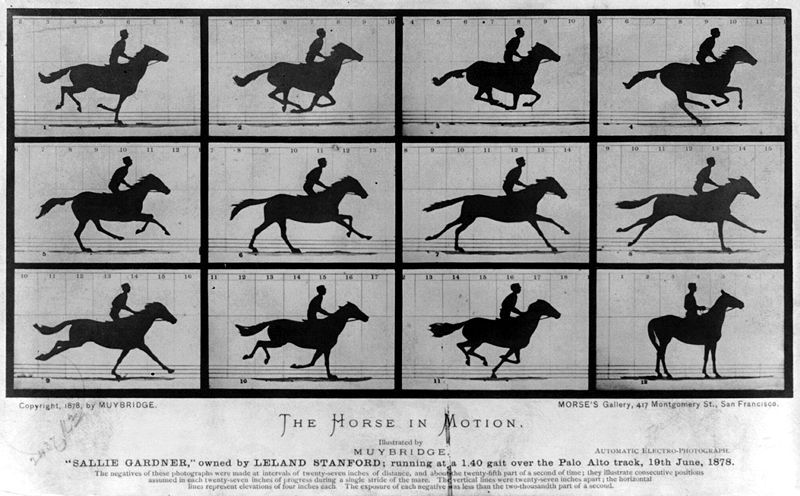 In 1872, former Governor of California Leland Stanford, a businessman and race-horse owner, had taken a position on a popularly-debated question of the day: whether all four of a horse's hooves are off the ground at the same time during a gallop.
Stanford sided with this assertion, called "unsupported transit", and took it upon himself to prove it scientifically. Stanford sought out photographer Eadweard Muybridge and hired him to settle the question.
A series of photos taken in Palo Alto, California, is called Sallie Gardner at a Gallop or The Horse in Motion, and shows that the hooves do all leave the ground — although not with the legs fully extended forward and back, as contemporary illustrators tended to imagine, but rather at the moment when all the hooves are tucked under the horse as it switches from "pushing" with the back legs to "pulling" with the front legs.
Muybridge used a battery of cameras lined along a track. The first camera had to be triggered manually, but the rest were automatically triggered by an electronic apparatus he designed.
This series of photos stands as one of the earliest forms of videography.
In 1872, former Governor of California Leland Stanford, a businessman and race-horse owner, had taken a position on a popularly-debated question of the day: whether all four of a horse's hooves are off the ground at the same time during a gallop.
Stanford sided with this assertion, called "unsupported transit", and took it upon himself to prove it scientifically. Stanford sought out photographer Eadweard Muybridge and hired him to settle the question.
A series of photos taken in Palo Alto, California, is called Sallie Gardner at a Gallop or The Horse in Motion, and shows that the hooves do all leave the ground — although not with the legs fully extended forward and back, as contemporary illustrators tended to imagine, but rather at the moment when all the hooves are tucked under the horse as it switches from "pushing" with the back legs to "pulling" with the front legs.
Muybridge used a battery of cameras lined along a track. The first camera had to be triggered manually, but the rest were automatically triggered by an electronic apparatus he designed.
This series of photos stands as one of the earliest forms of videography.
 Source
Source
Thursday, February 24, 2011
Can horses fly?
Subscribe to:
Post Comments (Atom)



No comments:
Post a Comment